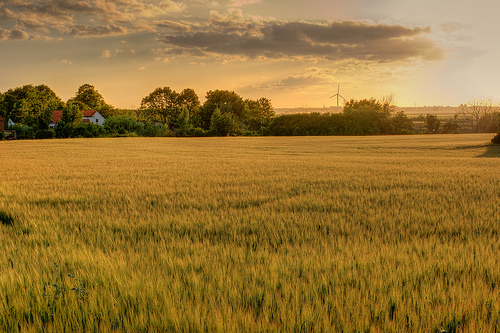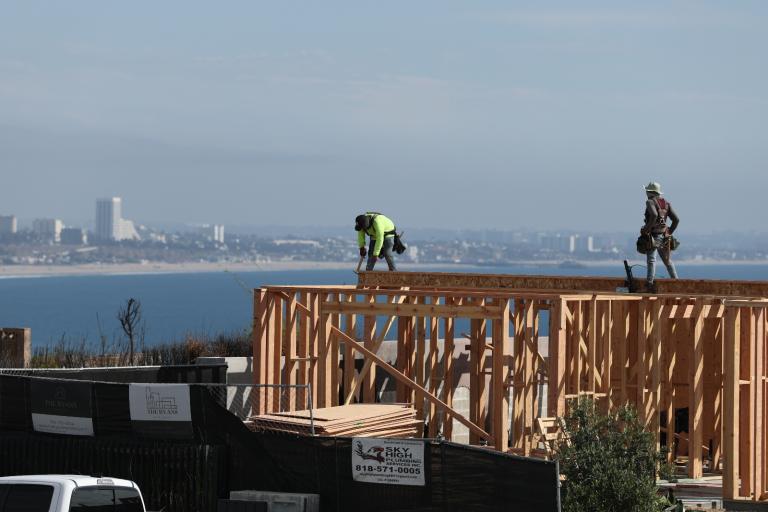Despite a sense that the international climate change negotiations, convened in Bonn, Germany this week, are grinding forward at a painfully slow pace, there is a momentum to the process that makes adding new ideas very difficult. It took several years of behind the scenes technical work and at least two years of carefully planned campaigning to get the deforestation issue substantively on the table. While we know that agriculture can make a vital contribution to addressing climate change, it lags behind the forest discussion and effectively including it in the Copenhagen deal at this late date will be no easy thing.
 Photo: Rutger BlomThe Food and Agriculture Organization summed up the complex agricultural and climate change interplay during a presentation at the climate negotiations last week. While trying to solve climate change, global population is still growing, though it will hopefully peak in the middle of the century at about 9 billion. As we strive to meet the Millennium Development Goals, affluence will also increase. The combination of population growth and the increase in wealth will require food production to increase 70%, with even larger increases for meat and milk. Meat consumption per capita in the developing world will still be low compared to the US, but one third of arable land is currently used for meat production, either as pasture or to grow feed crops, so growth will have a significant impact. Demand for bioenergy in many forms (some more efficient than others) will increase as we decarbonize the global economy. We will be trying to preserve the remaining standing tropical forests, despite increasing consumption of paper and wood products, agricultural pressures and bioenergy needs as diverse as charcoal for cookstoves and palm oil for cars. As if all this pressure on a finite land base and stretched water supply wasn’t enough, climate change will damage productivity. We’ve already seen Australia and California’s production hurt by their long term droughts, and the projections for Africa through 2030 are devastating. Climate change will even steal land right out from under farmers. For example, the IPCC warns that one meter of sea level rise will flood 100,000 hectares of cultivated land and aquaculture in the Mekong River delta.
Photo: Rutger BlomThe Food and Agriculture Organization summed up the complex agricultural and climate change interplay during a presentation at the climate negotiations last week. While trying to solve climate change, global population is still growing, though it will hopefully peak in the middle of the century at about 9 billion. As we strive to meet the Millennium Development Goals, affluence will also increase. The combination of population growth and the increase in wealth will require food production to increase 70%, with even larger increases for meat and milk. Meat consumption per capita in the developing world will still be low compared to the US, but one third of arable land is currently used for meat production, either as pasture or to grow feed crops, so growth will have a significant impact. Demand for bioenergy in many forms (some more efficient than others) will increase as we decarbonize the global economy. We will be trying to preserve the remaining standing tropical forests, despite increasing consumption of paper and wood products, agricultural pressures and bioenergy needs as diverse as charcoal for cookstoves and palm oil for cars. As if all this pressure on a finite land base and stretched water supply wasn’t enough, climate change will damage productivity. We’ve already seen Australia and California’s production hurt by their long term droughts, and the projections for Africa through 2030 are devastating. Climate change will even steal land right out from under farmers. For example, the IPCC warns that one meter of sea level rise will flood 100,000 hectares of cultivated land and aquaculture in the Mekong River delta.
We face a complex set of problems in agriculture aside from solving climate change, but there’s also a significant link to greenhouse gasses themselves. Analysis by FAO reports that forestry and agriculture together contribute 35% of the human released greenhouse gasses each year. This includes carbon dioxide released through logging and plowing, methane from livestock production and rice paddies, and nitrous oxide from nitrogen based fertilizers, as well as fossil fuel use during production. Thankfully, agriculture can be a big part of the solution [PDF].
Emissions can be reduced through changes in farming practices and improvements in efficiency, but most importantly we can store carbon in the soil of our pastureland and cropland, picking up some of the slack from our fossil fuel emissions. Getting agriculture right is crucial to solving a whole set of 21st century challenges.
So this brings us back to the climate negotiations and the road to Copenhagen. Through the hard work of many countries and NGO’s, slowing deforestation (Reduced Emissions from Deforestation and Degradation – REDD) will likely be a part of the deal. Agriculture however hasn’t had the same champions and has languished in the halls. Some forest advocates are even anti-agriculture, considering it the enemy of intact, natural forest. As a result, despite strong interactions on the ground, the two sectors don’t tend to coordinate policy or strategy. The forest negotiations have also been very complex, with countries advocating different approaches that are most advantageous to their own circumstances. Adding the tremendous complexity of agricultural interests to the mix ratchets up the discussion past the point of comprehension. The Doha round of WTO negotiations have broken down over issues in the agriculture sector and adding that difficult negotiation to the climate agreement seems unwise.
In the end though, an environmentally robust climate deal will have to address agriculture, both to take advantage of its mitigation potential and to ensure it does not undermine the forest portion of the deal. Countries have put placeholder text in the negotiating documents broaching the topic. Organizations like FAO and the Terrestrial Carbon Group have analyzed how we might implement solutions. On June 6th, alongside the negotiations, the UN Convention to Combat Decertification hosted “Land Day” to broaden the discussion beyond tropical forests and into the world’s drylands. Even Senator Richard Lugar (R-IN), the top Republican on the Senate Foreign Relations Committee, sees the link between agriculture and climate change in the international deal, according to his senior aide, Mark Helmke. There is still a great deal of work to do to ensure the global climate deal addresses the finite supply of land, water and biomass holistically but, as we hurtle (or trudge, it feels like both at the same time) towards Copenhagen, there are encouraging signs that agriculture will be on the table.




